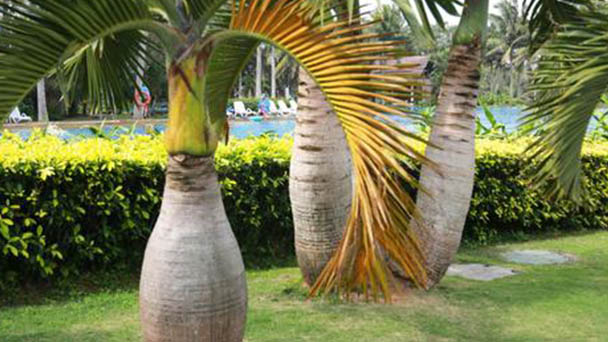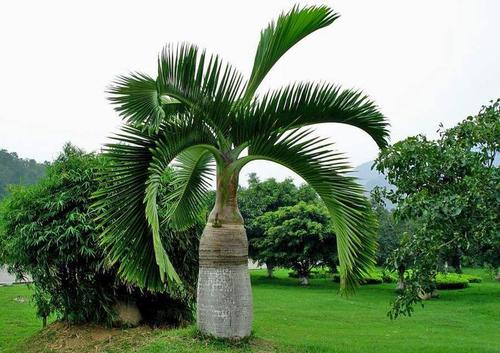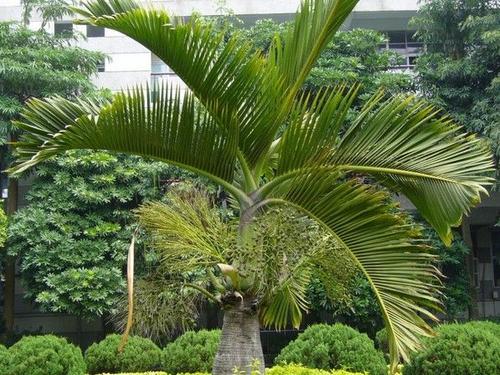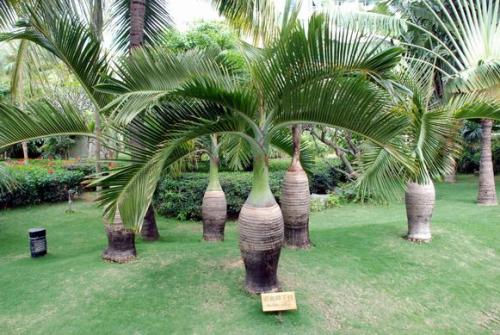Bottle Palm (Hyophorbe lagenicaulis) Profile
Written by Maggie
Sep 18 2021

Bottle Palm (Hyophorbe lagenicaulis) is short, fat like a bottle, high up to 3 meters above, the largest stem thick 38-60 cm.
Bottle Palm Picture

Bottle Palm morphological Characteristics
Bottle Palm, single, the trunk is short, fat like a Bottle, the height can be more than 3 meters, the maximum stem diameter 38-60 cm. Leaves are pinnately compound, leaflets lanceolate, 40-60 pairs, leaf sheaths cylindric. Petiole and leaves when seedlings are pale reddish-brown. As a result of its stem bulge, the leaf-shaped plant appears chic and beautiful. The stem is short and round like a wine bottle, 1 ~ 2.5 meters high. Compound leaves of bottle palm are pinnate, few, often not more than 5; Leaflets are linear-lanceolate, pale green. Spince much-branched, oily green. Berry is oval, dark brown when ripe.
Bottle Palm Ecological Habits
Bottle Palm is fond of high temperature, wet, sunny environments, afraid of cold, salt and alkali resistance, slow growth, winter needs to overwinter at above 10℃. Produce by seed, but pick and sow at once. The suitable temperature for seed germination is 25 ~ 28℃, and it takes 45 ~ 60 days after sowing to germinate. Bottle Palm grows slowly and is afraid of transplanting, so it is appropriate to use nutrition bags or flowerpots with good air permeability for sowing. Bottle Palm is a typical tropical Palm plant.
In addition to Hainan Province, southern Guangdong, southern Fujian, southeastern Guangxi and central and southern Taiwan, the area north of 26° N needs potted greenhouse for overwintering. Cultivation soil should be rich in humus loam or sandy loam with good drainage. After planting, the plant should be shaded and moisturized until the new roots are grown before being managed in full sunshine. During the vigorous growth in summer and autumn, the soil should be kept moist. During the growth period, regular topdressing is required, once a month, and potassium fertilizer is added at the end of autumn to improve cold tolerance. Bottle Palm likes dampness and is afraid of waterlogging. Red leaf mites are prone to harm in plum rain season, so they can be controlled by trichlorfon or dichlorvos spraying. However, if the soil is too dry, the leaf tip is easily withered and scorched, and the ornamental value is reduced.
How to Grow and Care for Bottle Palm
Bottle Palm Water care
Growing season watering rather dry do not wet, basin soil to keep wet, watering too much, easy to cause the lower part of the plant leaf rot disease, leading to the spread of black spot, resulting in leaf withered and even death. Water 2 ~ 3 times a day in summer, summer and autumn when the air is dry, often to the plant water, in order to improve the air humidity of the environment, so conducive to its growth, while maintaining the dark green and glossy foliage. Winter appropriate to reduce the amount of watering, in order to facilitate overwintering.
Bottle Palm Light care
Bottle Palm (Hyophorbe lagenicaulis) grows faster in high temperature, high humidity and semi-shade environments. It is afraid of direct sunlight. Under the hot sun, the leaf color of Bottle Palm will become pale or yellow, and coke leaves and black spots will be produced, losing its ornamental value. It is more tolerant to shade, seedling cultivation period or growth period, especially summer, autumn shade is generally 60%, but winter, spring to give a brighter scattering light is appropriate.
Cold Tolerance: Most enthusiasts agree that this species does not tolerate any type of freeze. There are a few nice sized hyophorbe lagenicaulis in Southern California (that I know of) but there are many more Spindle Palms. If you are container growing it, you can winter protect it inside the house or in the garage. Just keep it away from temperatures of 32 degrees or less.
Heat Tolerance: Interestingly, the Bottle Palm loves heat. The lack of summer heat will result in a plant that does not perform well.
Speed of Growth: In hot and more tropical areas, growth is slow to medium at best. Remember, it's never going to get tall. If you are in an area like Southern California, perhaps you can put on a few inches of trunk a year.

Bottle Palm Propagation
Selects the high quality Bottle Palm parent tree to pick seed, the pot sow, the box sow and the bed sow can be. Sowing a large number of seedbeds should be selected near the water source and flat sandy soil, and a little shade. Before sowing, seeds of bottle palm should be soaked in warm water to promote germination. The general method is to soak the seeds in warm water at 30 ~ 35℃ for 48 hours, rub off the wax of the seed epidermis, wrap it with gauze after taking it out, soak the seeds in warm water once every morning and evening, keep the seeds moist, when the seeds start to germinate, that is, sow. Bottle Palm seed coats are hard. Can also be in before sowing with a sharp knife near the eye, cut off a small piece of outer pericarp, and then soak seeds with warm water, so that its easy water germination. Sowing soil with plain sand is appropriate, the top of the seed up side by side oblique placed on the seedbed. Cover the soil with twice the diameter of the seed. After sowing, put the pot and box indoors and keep the room temperature at 25 ~ 30℃. Keep the soil in semi-shade and keep the soil moist.
Bottle Palm Disease Control
The main diseases and insect pests in Bottle Palm (Hyophorbe lagenicaulis) are heart rot and leaf blight.
Heart rot prevention and control methods: uprooting the disease plant and burning or burying it is one of the most effective prevention and control methods. The surrounding environment (including the plant) should be protected by spraying 1% Bordeaux solution after the disinfected plant is removed. The harm degree of this disease is considerable, once neglected. There will be varying degrees of loss.
Leaf blight control methods: at first, the disease spots are reddish-brown and round, then the disease spots connect and expand into irregular large spots, which are reddish-brown, and even the whole leaf is dead. Carbendazim or methyl tobuzine 800 times spray can be used to control the disease
Bottle Palm Distribution
Bottle palm (Hyophorbe lagenicaulis) distributes Morisi, Masgarini Island in China is distributed in Hainan. Origin: originally produced in the masklin islands, China's Taiwan, guangxi, hainan, guangdong, fujian and other places have been introduced to cultivation.
Bottle Palm Uses
Bottle Palm Garden Use
Bottle palm is very suitable for garden configuration and potted ornamental.
Bottle Palm is peculiar in shape and slow in growth. It usually takes more than 20 years from seed breeding to flowering and bearing fruit, and it takes 18 months for each plant to blossom and mature fruit, but its life can be as long as decades. Bottle palm looks like a Bottle and is very beautiful. Bottle palm can be potted for decoration of hotel halls and large shopping malls, but also can be planted alone in the lawn or courtyard, the ornamental effect is excellent. In addition, Bottle Palm is one of the few Palm plants that can be directly planted on the seaside, just like Chinese Palm and queen sunflower.
Cooking
To increase your intake of medium-chain fats, it's easiest to replace other cooking oils with coconut oil. Since coconut oil is saturated, it does not produce free radicals when heated. Coconut oil has a melting point of 23 ° C, above which it is a liquid; Below this temperature is a white paste. Bottle palm smoke point is low, below 177℃. Coconut oil can be used to bake bread, muffins or cook at a temperature higher than this. Due to the humidity of the food, the internal temperature can still be less than 100℃. Be aware that any cooking oil, if overheated, can produce harmful substances. Coconut oil is stable and does not require refrigeration.It can be kept at room temperature for at least 2-3 years.
Food
Bottle palm (Hyophorbe lagenicaulis) contains protein and most vegetables, but also contains a variety of vitamins and minerals. Fresh coconut and shredded coconut are both good sources of fiber, which can promote the normal functioning of the digestive tract. It's easy to buy coconuts in stores. One cup of shredded coconut contains about 9 grams of fiber, three to four times more than the average vegetable or fruit. Coconut jerky contains water 2.5%, in the drying process (drying or baking) little fat loss, can be stored for several months.Fresh coconut contains 52 percent water, which rots and becomes moldy after a few days in the open. (Coconut food only kills bacteria when it gets into our bodies and breaks down into fatty acids.)
Fresh coconuts can be eaten as a dish or as a snack. When buying coconut, you can pick up the coconut shake, and hear the sound of the liquid inside the fresh coconut. The one with no juice inside is the old coconut. One of the three umbilical holes found in the hard shell of a coconut can be pierced if poked, and the coconut water can be poured into a cup to drink. Coconut water is colorless, slightly cloudy and slightly sweet. After breaking the shell, dig out the white flesh, and use a knife to peel off the hard brown outer skin of the flesh. Serve.
Coconut milk (or coconut milk) is made by grinding the flesh of the coconut and squeezing out the juice. Bottle palm is milky white, opaque as milk, and has no sweetness. Bottle palm contains 17 -- 24 percent fat.Coconut milk is sold in cans at the store. Bottle palm can be served cold or hot, or mixed with other beverages. Bottle palm is also used as a seasoning for dishes.

Latest Updated
- Benefits of Bugleweed - 7 Science-backed Health Benefits
- Bugleweed Dangers & Side Effects - Is It Poisonous?
- How to Plant Evergreen Trees - What You Should Know
- When to Plant Evergreens - Grow Guide for Evergreen Trees
- 12 Wonderful Evergreen Shrubs for Your Garden
- 12 Popular Evergreen Plants with Pictures for Beginners
- When And How To Prune A Lilac Bush Like a Pro
- How to Grow & Care for Lilac Vine (Hardenbergia Violacea)
- Japanese Lilac Tree (Syringa Reticulata) Care & Propagation Guide
- Shumard Oak Pros and Cons - What to Know
Popular Articles
- Winter maintenance of Antirrhinum Majus
- How to Grow Terminalia Mantaly Tree
- How to Grow and Care for Crossostephium Chinense
- How to grow Antirrhinum Majus in spring
- Peristeria Elata (Dove Orchid) Profile: Info & Care Guide
- Underwatered Snake Plant (Sansevieria Trifasciata) - Signs And How To Fix
- How to Care for Brazilian Jasmine Plant (Mandevilla Sanderi)
- How to Grow & Care for Graptopetalum Purple Delight in Summer
- Rosa Chinensis (China Rose): Plant Growing & Care Tips
- How to Care for Baby Sun Rose (Aptenia Cordifolia)